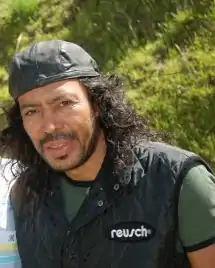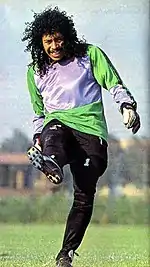René Higuita
José René Higuita Zapata (Spanish pronunciation: [reˈne iˈɣita]; born 27 August 1966) is a Colombian former professional footballer who played as a goalkeeper. He was nicknamed El Loco ("The Madman") for his high-risk 'sweeper-keeper' playing style and his flair for the dramatic.
 Higuita in 2007 | |||
| Personal information | |||
|---|---|---|---|
| Full name | José René Higuita Zapata | ||
| Date of birth | 27 August 1966 | ||
| Place of birth | Medellín, Colombia | ||
| Height | 1.75 m (5 ft 9 in)[1] | ||
| Position(s) | Goalkeeper | ||
| Club information | |||
Current team | Atlético Nacional (goalkeeper coach) | ||
| Youth career | |||
| Millonarios | |||
| Senior career* | |||
| Years | Team | Apps | (Gls) |
| 1985 | Millonarios | 16 | (7) |
| 1986–1992 | Atlético Nacional | 112 | (1) |
| 1992 | Real Valladolid | 15 | (2) |
| 1993–1997 | Atlético Nacional | 69 | (1) |
| 1997–1998 | Veracruz | 30 | (2) |
| 1999–2000 | Independiente Medellín | 20 | (11) |
| 2000–2001 | Real Cartagena | 21 | (0) |
| 2001–2002 | Atlético Junior | 4 | (0) |
| 2002–2003 | Deportivo Pereira | 13 | (0) |
| 2004 | Aucas | 35 | (3) |
| 2007 | Guaros FC | 10 | (5) |
| 2008 | Deportivo Rionegro | 10 | (3) |
| 2008–2009 | Deportivo Pereira | 12 | (5) |
| Total | 380 | (41) | |
| National team | |||
| 1987–1999 | Colombia[2] | 68 | (3) |
| * Senior club appearances and goals counted for the domestic league only | |||
Higuita's style of play, which was first shown to a global audience during the 1990 FIFA World Cup, was pioneering in influencing goalkeepers to take more responsibility for situations further from the goal.[3]
IFFHS ranked Higuita the 8th best South American keeper in history.[4]
He is also ranked as one of the 10 highest-scoring goalkeepers in history, with 41 goals overall.[5]
Early life
Higuita was born in Medellín, Antioquia to a single mother, Maria Dioselina. His mother died when he was very young, so his grandma had to take care of him. He was very poor as a child, so he had to work as newspaper mailman and many other jobs in order to survive.
Club career
Higuita started his playing career with Millonarios and transferred to Atlético Nacional in 1986. He played the majority of his club career with the Colombian side where he helped the team win the Colombian League on numerous occasions as well as the Copa Libertadores and Copa Interamericana, both in 1989. After leaving them, he moved to Spain to play with Real Valladolid for one season, before coming back to Atletico Nacional for four years. He then left for Mexico to play for Veracruz before coming back to the Colombian league to play for Atletico's city rivals, Independiente Medellín.
He briefly retired in 2005 after failing a drug test while playing for Aucas.
He came out of retirement on 21 July 2007 to sign for Venezuelan club Guaros FC. In January 2008, aged 41, he signed for the Colombian second division team Deportivo Rionegro. In June 2008 he signed for another Colombia team, Deportivo Pereira, and finally retired on 25 January 2010.[6]
International career

Higuita's first major tournament was the 1989 Copa América, where the team was knocked out in the first round. In the 1990 FIFA World Cup, he played an important part to lead the country into the round of 16 for the first time ever. However, Higuita's unorthodox playing style caused a mistake by him that knocked Colombia out of the World Cup, when he tried to feint Cameroon striker Roger Milla but failed, and Milla dispossessed him and scored, which put Cameroon through to the quarter-finals. Higuita described it as "a mistake as big as a house".[7] As a result of such behaviour, Higuita was nicknamed El Loco ("The Madman").[8]
He played in the 1991 Copa América where the team finished fourth. His last call up for the national team was for the 1999 Copa América.
Higuita often took set-pieces for the Colombian national team, in all, he scored three goals in his 68 international appearances.
Style of play
On the pitch, Higuita was known for his dramatic flair, composure under pressure, and eccentric playing style, often taking unnecessary risks and actively coming out of his area to anticipate opponents, play the ball out to defenders, undertake individual dribbling runs, and attempt to score goals, which led him to be described as a 'sweeper-keeper'; he was therefore a pioneer in influencing other goalkeepers to take more responsibility for situations further away from the goal.[3] Although he was a goalkeeper, Higuita also became known for scoring directly from free-kicks, as well as penalties.[9]
His style of play led to the creation of the Back-pass rule, which is also known as the Higuita Law.
IFFHS ranked Higuita the 8th best keeper in South American history.
Higuita's style of play, which was first shown to a global audience during the 1990 FIFA World Cup, was pioneering in influencing goalkeepers to take more responsibility for situations further from the goal.
Scorpion Kick
Furthermore, Higuita reportedly invented the scorpion kick, a movement which involves the player jumping forward, positioning their legs over their head, and in doing so, kicks the ball away with their heels; one of Higuita's most notable uses of the scorpion was when he performed it while clearing a cross from Jamie Redknapp during a friendly against England at Wembley Stadium on 6 September 1995, earning him considerable media attention.[8] It ranked 94th in Channel 4's 100 Greatest Sporting Moments in 2002.[10]
Coaching career
Higuita has expressed the wish to coach the Colombian national team and in December 2008 he got the job of goalkeeper coach for his former club Real Valladolid.[11]
He joined Al Nassr FC in Saudi Arabia in 2011, and was the club goalkeeper coach for about 5 years, until 2016.
He rejoined Atletico Nacional on 28 June 2017 after receiving a coaching job as the goalkeeping coach. Upon rejoining, he said "the dream of my life was to return to Atletico Nacional".[12]
Personal life
Higuita was friends with Diego Maradona and played in the Argentine's farewell match in 2001.[13]
Higuita was imprisoned in 1993 after getting involved in a kidnapping. Acting as a go-between for the drug barons Pablo Escobar and Carlos Molina, he was largely responsible for securing the release of Molina's daughter by delivering the ransom money. He received $64,000 for his services, which breaks Colombian law as it is an offence to profit from a kidnapping. He was incarcerated for seven months before being released without charge. Commenting on the case, he has stated that "I'm a footballer, I didn't know anything about kidnapping laws."[14]
In the ESPN documentary "The Two Escobars", Higuita claimed that he was arrested for visiting Pablo during his time in prison with the desire to thank him for turning himself in thus stabilizing Colombia for a short period. He supported this theory claiming that all he was asked during questioning was solely about Pablo Escobar himself and no kidnapping.[15]
Because of the term in prison Higuita was not fit for the 1994 FIFA World Cup. In another scandal, he tested positive for cocaine on 23 November 2004 while playing for Aucas, an Ecuadorian football club.[16][17]
In 2005, Higuita participated in the reality TV program La isla de los famosos: Una aventura pirata ("The Island of the Famous: A Pirate Adventure"), a show similar to Survivor. Also in 2005, he underwent plastic surgery to completely change his appearance.[18]
Higuita has expressed the wish to become more politically active.[19]
Career statistics
International goals
Scores and results lists Colombia's goal tally first.[20]
| # | Date | Venue | Opponent | Score | Result | Competition |
|---|---|---|---|---|---|---|
| 1. | 19 May 1988 | Helsinki Olympic Stadium, Helsinki, Finland | Friendly | |||
| 2. | 3 February 1989 | Estadio Centenario, Armenia, Colombia | Copa Centenario de Armenia | |||
| 3. | 3 July 1989 | Estádio Fonte Nova, Salvador, Brazil | 1989 Copa América |
Honours
Club
Atlético Nacional
- Copa Libertadores: 1989; Runner-up 1995.
- Copa Interamericana: 1990.
- Intercontinental Cup: Runner-up 1989.
- Colombian League: 1991, 1994.
Individual
- South American Team of the Year: 1989, 1990[21]
- Golden Foot Legends Award: 2009[22]
References
- "René Higuita". worldfootball.net. Retrieved 29 March 2020.
- "RSSSF".
- Tim Vickery (10 February 2010). "The Legacy of Rene Higuita". BBC. Retrieved 11 June 2014
- "Rene Higuita Biography, Career Info, Records & Achievements". www.sportskeeda.com. Retrieved 30 May 2019.
- Bailey, Ryan. "The 10 Best Goalscoring Goalkeepers". Bleacher Report. Retrieved 30 May 2019.
- Tim Vickery. "The legacy of Rene Higuita". Bbc.co.uk. Retrieved 30 June 2014.
- Shaw, Phil (16 February 1998). "Schmeichel slices into fixture". The Independent.
- "Colombia 'scorpion kick' keeper Higuita runs for mayor". BBC News. 19 March 2011.
- "Rogerio Ceni: Sao Paulo keeper into club record books". BBC. 4 June 2015. Retrieved 3 April 2016.
- 100 Greatest sporting moments – results Channel 4. Retrieved 28 August 2014
- "René Higuita, nuevo preparador de porteros en". Elvalladolid.com. Archived from the original on 17 September 2009. Retrieved 30 June 2014.
- Lines, Oliver. "Scorpion kick goalkeeper Higuita joins Atletico Nacional". Sportstar. Retrieved 30 May 2019.
- "Argentina cries for 'that hand of God' as Maradona bids farewell to". The Independent. 12 November 2001. Retrieved 30 May 2019.
- René 'el Loco' Higuita leads Ecuador's keepers – FIFA.com 22 September 2004 Archived 15 May 2006 at the Wayback Machine
- "The Two Escobars - ESPN Films: 30 for 30". www.espn.com. Retrieved 30 May 2019.
- Vickery, Tim (29 November 2004). "Two of the best". BBC News. Retrieved 30 June 2014.
- "Whatever happened to Rene Higuita? Pablo Escobar's scorpion-kicking friend revolutionised goalkeeping | Goal.com". www.goal.com. Retrieved 30 May 2019.
- (in Spanish) Inconforme René Higuita por cambio físico a que fue sometido (El Universal)
- "Higuita wants to return to Colombia's national team". Colombia Reports. 1 April 2008. Archived from the original on 25 April 2008. Retrieved 1 April 2008.
- Ballesteros, Frank (12 February 2006). "José René Higuita - International Appearances". The Rec.Sport.Soccer Statistics Foundation. Retrieved 7 August 2014.
- "South American Team of the Year". RSSSF. 16 January 2009. Retrieved 18 May 2017.
- "Legends". Golden Foot. Archived from the original on 25 September 2015. Retrieved 23 September 2015.
External links
| Wikimedia Commons has media related to René Higuita. |
- René Higuita at National-Football-Teams.com
- International statistics at rsssf
- Rene Higuita Career Info and Achievements
- FIFA interview with René Higuita
- BBC SPORT Tim Vickery The legacy of Rene Higuita
- René Higuita clips: Part 1; Part 2; Part 3; Part 4